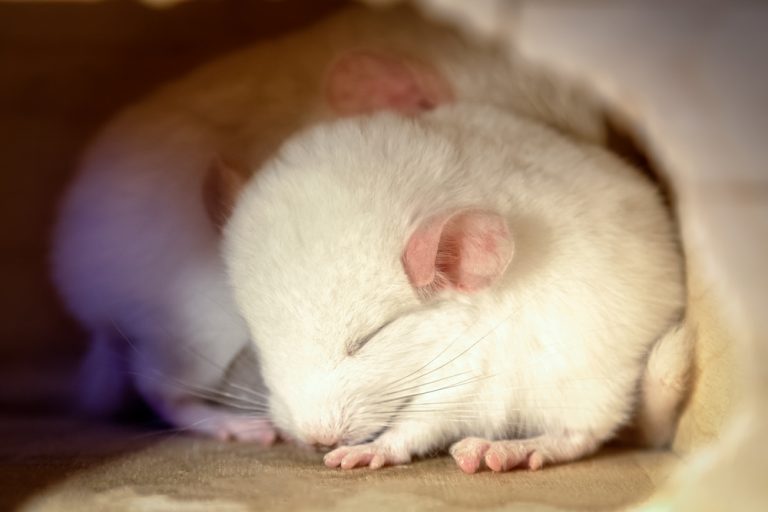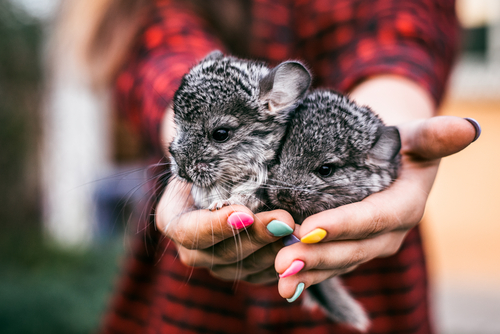Are Chinchillas Hypoallergenic?
If you’re allergic to animal hair or dust but still want the companionship of a pet, you’ll need to search for a suitable, hypoallergenic pet. Rodents often are more allergenic than other pets. Picking a rodent as a pet can be problematic if you suffer from allergies. If you want to be entirely sure that you won’t get any allergic reactions, you want to get a hypoallergenic pet.
Are chinchillas hypoallergenic? Chinchillas are hypoallergenic in the sense that they’re less likely to cause allergic reactions. They don’t shed as much hair and dander as other pets. Sadly, allergic reactions are not only caused by dander, but also by contact with saliva and urine. So, they’re not entirely free of allergens and the products you use to care for your chinchilla can also cause allergic reactions.
So the answer to being hypoallergenic isn’t that straightforward. There are a lot of products that you’ll use to take care of your chinchilla that can cause an allergic reaction. I’m thinking of the bedding for the cage and the chinchilla dust you’ll need to give your chinchilla a dust bath.
To understand the possible hazards a little better, it’s best to understand what causes allergies and what it means to have a hypoallergenic pet. In this article, you’ll learn this, and also why chinchillas are considered hypoallergenic and what products can cause allergic reactions. I’ll also give some tips and tricks to avoid getting allergic to your pet.
This site contains affiliate links to products we recommend and use ourselves. We may receive a commission for purchases that you make through these links. If you’re interested in learning more about our affiliate links, please visit our (affiliate) disclaimer.
Pet Allergies
What causes a pet allergy?
The saliva, dander (this are dead skin cells) and urine of your pet contain certain proteins. Some people have very sensitive and over-sensitive immune systems that react with these – normally harmless – proteins and this causes an allergic reaction.
The substances that cause an allergic reaction are also called allergens. In the case of pets, these allergens are:
- saliva
- dander
- urine
Allergens of small rodents, like the chinchilla, typically won’t be found all over the place in the house. However, you can come in contact with them when you handle them and when you clean their cage. Contrary to dogs and cats, a chinchilla will spend most of their time in the cage and won’t explore the entire house every day. But if you handle your chinchilla the allergens can transfer to other places around the house.
It’s important to notice that the hair of your pets is not an allergen by itself but it does collect dander, urine, and saliva. When your pet sheds or when you groom it, these particles can come in the air and can stay in the air for a long time.
Symptoms of pet allergies
There are a lot of different symptoms related to pet allergies. The most common symptoms of pet allergies result when the nasal passages become inflamed.
- runny nose
- nasal congestion
- cough
- postnasal drip
- sneezing
- itchy nose or throat
- watery, red or itchy eyes
- blue and swollen skin beneath the eyes
- facial pain and pressure
If you’re having asthma, pet allergies also can include
- pain or tightness in the chest
- difficulty breathing
- wheezing or whistling when exhaling
- skin symptoms
- difficulty sleeping due to wheezing, coughing or shortness of breath
If your pet allergies are causing skin symptoms, this is called allergic dermatitis. This is due to the reaction of your immune system. This condition can result from a pet known to cause allergies such as itchy skin, eczema, and hives.
Allergies don’t always come up all of a sudden. Most pet allergies come after a long period of time and exposure. So, it’s possible that you’re not allergic at the moment but may have allergic reactions later.
The Hypoallergenic Chinchilla
What does hypoallergenic mean?
When something is less likely to trigger an allergic reaction, it is referred to as hypoallergenic. The term originated in 1953 during a cosmetics campaign.
Hypoallergenic doesn’t mean that a pet is completely free of allergens. The term consists of the Greek term “hypo” which means “below normal” or “slightly”. Hypoallergenic products or pets still cause allergic reactions but are often less likely to cause a (severe) allergic reaction. Still it’s possible for people with severe allergies and asthma to be affected by hypoallergenic items and pets.
Why is a chinchilla hypoallergenic?
Chinchillas are considered hypoallergenic because they produce very little dander. Many individuals allergic to other pets with fur are able to have a chinchilla with no issues. Chinchillas are not non-allergenic. Even though they shed far less than other animals, their soft, lush fur does shed to some extent. This is most commonly due to temperature changes as the season changes.
Why chinchillas can still cause allergies?
In some instances, you may be allergic to the items or food in the habitat as opposed to the chinchilla itself. Chinchillas also shed their fur approximately once every three months. The most common cause of allergies is the dust and hay from the animal. If you are allergic to dust or hay, measures can be taken to control your allergies.
The majority of animals with fur and warm blood have proteins inside of their bodies. They groom their fur using their tongues. This results in saliva on their fur. Once this has dried, pieces of this protein make their way into the air. They land on numerous materials such as upholstered furniture, carpeting, and rugs. This can cause an allergic reaction in some individuals. To maintain their health, chinchillas must take a bath in powdery dust numerous times each week. This is what removes the greasiness from their fur. As the chinchilla rolls in the dust and shakes to remove the excess, the dust becomes airborne. This causes an allergic reaction in anyone allergic to dust.
The bottom of a chinchillas cage must be lined with wood shavings for their bedding to absorb the urine. The same is true for the majority of pet rodents. The normal activity of a chinchilla causes the pine dust to become airborne. Since chinchillas are very active not only during the day but even more so during the night, this can cause an allergic reaction. The basic diet of a chinchilla is timothy hay, dry alfalfa, and food pellets. When the chinchilla is eating, dust from the hay becomes airborne. This may cause issues for anyone with hay allergies. Ensuring chinchillas have dust or hay baths is critical for their health. Depriving them of this activity is extremely cruel.
Tips and Tricks
When you’re having an allergic reaction to your chinchilla, it’s often a matter of time before you give your chinchilla away. Depending on the severity of your allergy, this can be indeed the best treatment. But there are several ways to reduce the exposure to allergens and keep your loving pet.
- don’t place the cage in a bedroom: you should keep the chinchilla in a room you don’t frequent regularly and should never place it in a bedroom since you spent on average 8 hours a day in this room.
- stay away from the dust bath: place the container of dust in the cage, cover the cage with a sheet and leave the room. Let your chinchilla bath at least ten minutes and then you can go back in.
- look for sand that is less airborne for a dust bath: there are a few different types of sands that you can use in a dust bath that are less airborne.
- use a closed container for the dust bath: this way you can prevent the dust from flying all over the cage and room.
- purchase a high-quality air purifier: these kinds of purifiers remove a lot of dust and allergens in the air even before it has a chance to settle. It is important to clean or replace the filter on a regular basis to ensure the air purifier remains operational.
- place the cage in a well-ventilated room: make sure that the cage is in a room that has enough ventilation but also make sure that there isn’t drought or your chinchilla might get sick.
- take precautions when cleaning the cage: you can wear a mask and gloves when cleaning the cage and change the bedding. It’s also best to take the cage outside to clean it. This will prevent the small allergens from scattering throughout the house.
- have your antihistamines readily available: if you already take antihistamines for allergies, make sure you have them with you. Since the chemicals produced by your immune system are what cause allergies, a 24-hour, non-drowsy antihistamine may be able to effectively manage your allergies.
- consult a medical professional when you experience allergies: if you notice symptoms of a (pet) allergy you want to contact a medical professional to see what causes the symptoms and create a treatment plan.




